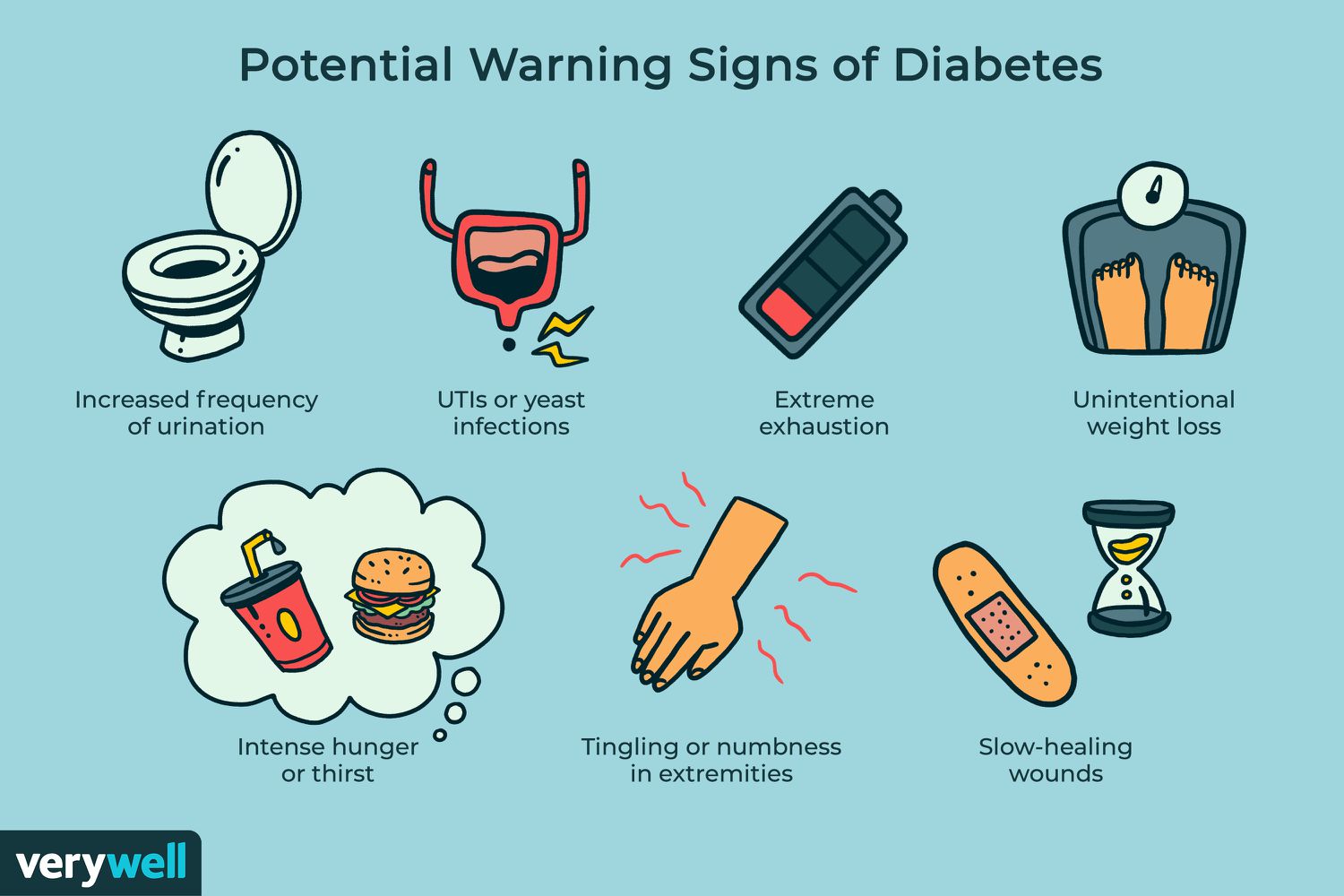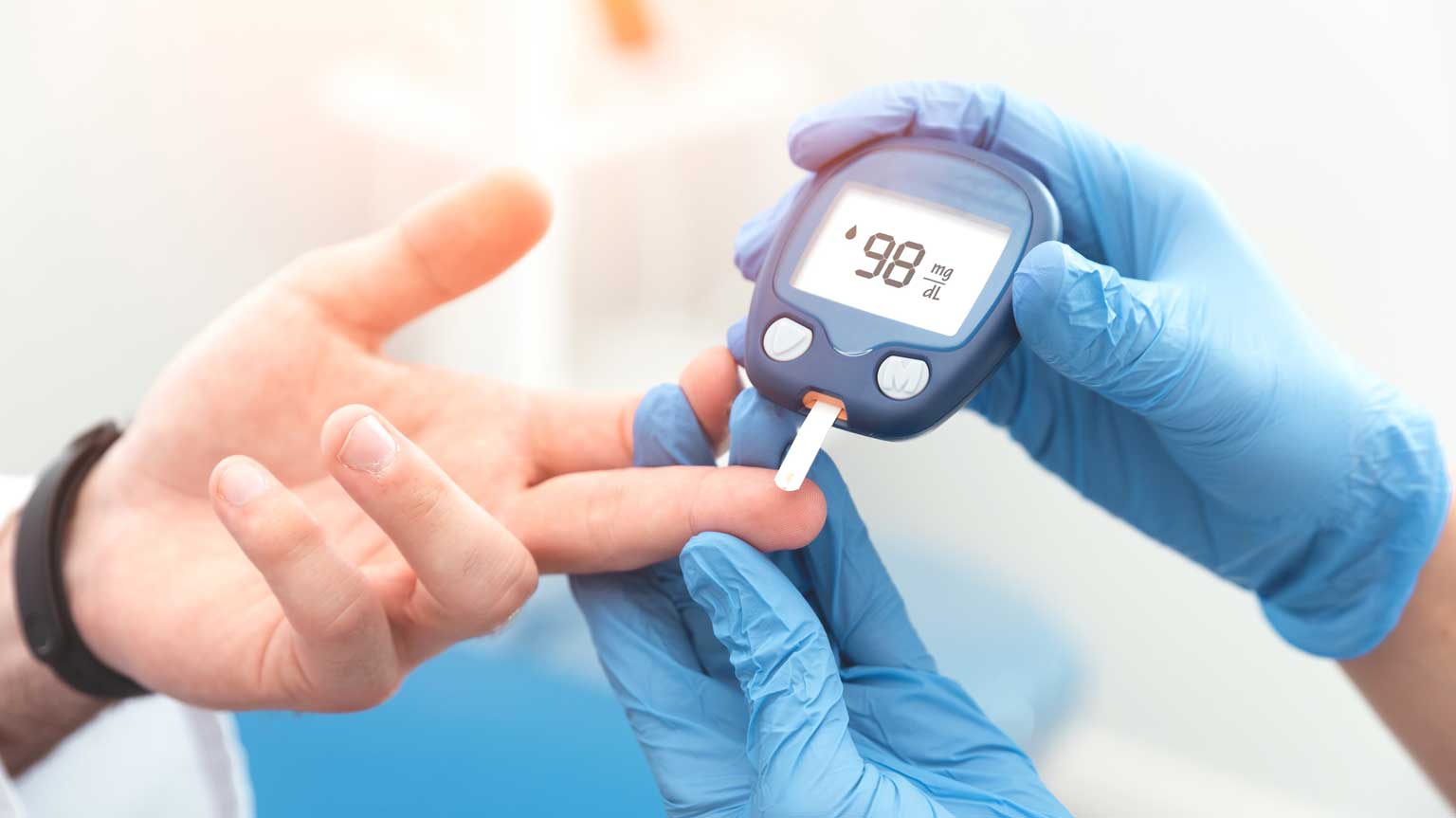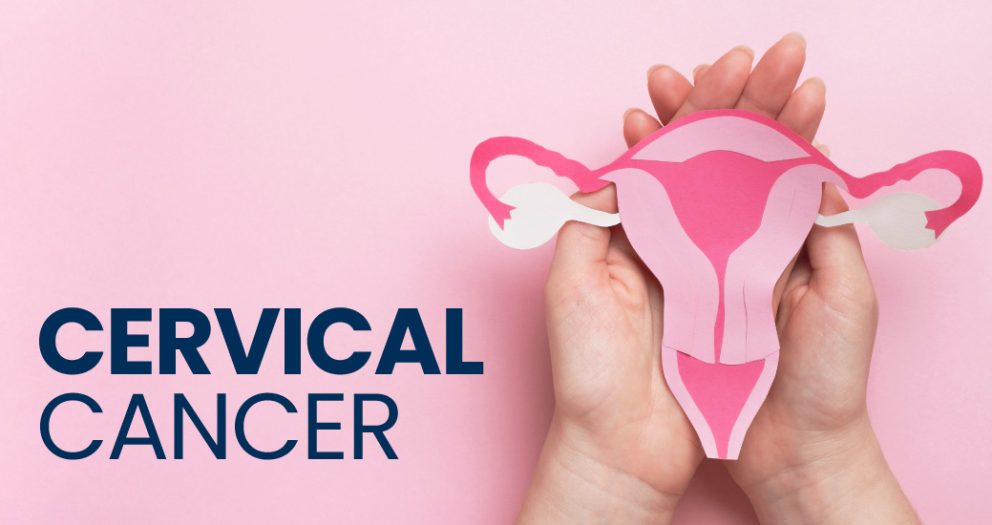Diabetes is a chronic (long-lasting) health condition that affects how your body turns food into energy.
Your body breaks down most of the food you eat into sugar (glucose) and releases it into your bloodstream. When your blood sugar goes up, it signals your pancreas to release insulin. Insulin acts like a key to letting the blood sugar into your body’s cells for use as energy.(1)
With diabetes, your body doesn’t make enough insulin or can’t use it as well as it should. Too much blood sugar stays in your bloodstream when there isn’t enough insulin or cells stop responding to insulin. Over time, that can cause serious health problems, such as heart disease, vision loss, and kidney disease.(1)
Types of Diabetes (2)
- Type 1 diabetes: This type is an autoimmune disease, meaning your body attacks itself. In this case, the insulin-producing cells in your pancreas are destroyed. Up to 10% of people who have diabetes have Type 1. It’s usually diagnosed in children and young adults (but can develop at any age). It was once better known as “juvenile” diabetes. People with Type 1 diabetes need to take insulin every day. This is why it is also called insulin-dependent diabetes.(2)
- Type 2 diabetes: With this type, your body either doesn’t make enough insulin or your body’s cells don’t respond normally to the insulin. This is the most common type of diabetes. Up to 95% of people with diabetes have Type 2. It usually occurs in middle-aged and older people. Other common names for Type 2 include adult-onset diabetes and insulin-resistant diabetes. Your parents or grandparents may have called it “having a touch of sugar.”(2)
- Prediabetes: This type is the stage before Type 2 diabetes. Your blood glucose levels are higher than average but not high enough to be officially diagnosed with Type 2 diabetes.
- Gestational diabetes: This type develops in some women during their pregnancy. Gestational diabetes usually goes away after pregnancy. However, if you have gestational diabetes you’re at higher risk of developing Type 2 diabetes later on in life.
Less common types of diabetes include:(2)
- Monogenic diabetes syndromes: These are rare inherited forms of diabetes accounting for up to 4% of all cases. Examples are neonatal diabetes and maturity-onset diabetes of the young.
- Cystic fibrosis-related diabetes: This is a form of diabetes-specific to people with this disease.
- Drug or chemical-induced diabetes: Examples of this type happen after organ transplant, following HIV/AIDS treatment, or are associated with glucocorticoid steroid use.
Diabetes insipidus is a specific rare condition that causes your kidneys to produce a large amount of urine.
Risk factors of diabetes(3)
Type 1
This type usually starts in childhood. Your pancreas stops making insulin. You have type 1 diabetes for life. The main things that lead to it are:(3)
- Family history. If you have relatives with diabetes, chances are higher that you’ll get it, too. Anyone who has a mother, father, sister, or brother with type 1 diabetes should get checked. A simple blood test can diagnose it.
- Diseases of the pancreas. They can slow its ability to make insulin.
- Infection or illness. Some infections and illnesses, mostly rare ones, can damage your pancreas.
Type 2
If you have this kind, your body can’t use the insulin it makes. This is called insulin resistance. Type 2 usually affects adults, but it can begin at any time in your life. The main things that lead to it are:(3)
- Obesity or being overweight. Research shows this is a top reason for type 2 diabetes. Because of the rise in obesity among U.S. children, this type is affecting more teenagers.
- Impaired glucose tolerance. Prediabetes is a milder form of this condition. It can be diagnosed with a simple blood test. If you have it, there’s a strong chance you’ll get type 2 diabetes.
- Insulin resistance. Type 2 diabetes often starts with cells that are resistant to insulin. That means your pancreas has to work extra hard to make enough insulin to meet your body’s needs.
- Ethnic background. Diabetes happens more often in Hispanic/Latino Americans, African-Americans, Native Americans, Asian Americans, Pacific Islanders, and Alaska natives.
- Gestational diabetes. If you had diabetes while you were pregnant, you had gestational diabetes. This raises your chances of getting type 2 diabetes later in life.
- Sedentary lifestyle. You exercise less than three times a week.
- Family history. You have a parent or sibling who has diabetes.
- Polycystic ovary syndrome. Women with polycystic ovary syndrome (PCOS) have a higher risk.
- Age. If you’re over 45 and overweight or if you have symptoms of diabetes, talk to your doctor about a simple screening test.
Gestational
Diabetes when you’re expecting effects about 4% of all U.S. pregnancies. It’s caused by hormones the placenta makes or by too little insulin. High blood sugar from the mother causes high blood sugar in the baby. That can lead to growth and development problems if left untreated. Things that can lead to gestational diabetes include:(3)
- Obesity or being overweight. Extra pounds can lead to gestational diabetes.
- Glucose intolerance. Having glucose intolerance or gestational diabetes in the past makes you more likely to get it again.
- Family history. If a parent or sibling has had gestational diabetes, you’re more likely to get it.
- Age. The older you are when you get pregnant, the higher your chances are.
- Ethnic background. Nonwhite women have a greater chance of developing it.

Diabetes Symptoms(4)
If you have any of the following diabetes symptoms, see your doctor about getting your blood sugar tested:(4)
- Urinate (pee) a lot, often at night
- Are very thirsty
- Lose weight without trying
- Are very hungry
- Have blurry vision
- Have numb or tingling hands or feet
- Feel very tired
- Have very dry skin
- Have sores that heal slowly
- Have more infections than usual
Diabetes Tests
Tests for Type 1 Diabetes, Type 2 Diabetes, and Prediabetes
Your doctor will have you take one or more of the following blood tests to confirm the diagnosis:(5)
A1C Test
The A1C test measures your average blood sugar level over the past 2 or 3 months. An A1C below 5.7% is normal, between 5.7 and 6.4% indicates you have prediabetes, and 6.5% or higher indicates you have diabetes.(5)
Fasting Blood Sugar Test
This measures your blood sugar after an overnight fast (not eating). A fasting blood sugar level of 99 mg/dL or lower is normal, 100 to 125 mg/dL indicates you have prediabetes, and 126 mg/dL or higher indicates you have diabetes.(5)
Glucose Tolerance Test
This measures your blood sugar before and after you drink a liquid that contains glucose. You’ll fast (not eat) overnight before the test and have your blood drawn to determine you are fasting blood sugar level. Then you’ll drink the liquid and have your blood sugar level checked for 1 hour, 2 hours, and possibly 3 hours afterward. At 2 hours, a blood sugar level of 140 mg/dL or lower is considered normal, 140 to 199 mg/dL indicates you have prediabetes, and 200 mg/dL or higher indicates you have diabetes.(5)
Random Blood Sugar Test
This measures your blood sugar at the time you’re tested. You can take this test at any time and don’t need to fast (not eat) first. A blood sugar level of 200 mg/dL or higher indicates you have diabetes.
Tests for Gestational Diabetes
Glucose Screening Test
This measures your blood sugar at the time you’re tested. You’ll drink a liquid that contains glucose, and then 1 hour later your blood will be drawn to check your blood sugar level. A normal result is 140 mg/dL or lower. If your group is higher than 140 mg/dL, you’ll need to take a glucose tolerance test.(5)
Glucose Tolerance Test
This measures your blood sugar before and after you drink a liquid that contains glucose. You’ll fast (not eat) overnight before the test and have your blood drawn to determine your fasting blood sugar level. Then you’ll drink the liquid and have your blood sugar level checked for 1 hour, 2 hours, and possibly 3 hours afterward. Results can differ depending on the size of the glucose drink and how often your blood sugar is tested. Ask your doctor what your test results mean.(5)
Treatment
Depending on what type of diabetes you have, blood sugar monitoring, insulin and oral drugs may be part of your treatment. Eating a healthy diet, staying at a healthy weight, and getting regular physical activity also are important parts of managing diabetes.
Diabetes and diet
An important part of managing diabetes is keeping a healthy weight through a healthy diet and exercise plan:(6)
- Healthy eating. There’s no specific diabetes diet. You’ll need to focus your diet on more fruits, vegetables, lean proteins, and whole grains. These foods are high in nutrition and fiber and low in fat and calories. You’ll also cut down on saturated fats, refined carbohydrates, and sweets. In fact, it’s the best eating plan for the entire family. Sugary foods are OK once in a while. They must be counted as part of your meal plan.
- Physical activity. Everyone needs regular aerobic activity. This includes people who have diabetes. Physical activity lowers your blood sugar level by moving sugar into your cells, where it’s used for energy. Physical activity also makes your body more sensitive to insulin. That means your body needs less insulin to transport sugar to your cells.
Get your provider’s OK to exercise. Then choose activities you enjoy, such as walking, swimming or biking. What’s most important is making physical activity part of your daily routine.
Aim for at least 30 minutes or more of moderate physical activity most days of the week, or at least 150 minutes of moderate physical activity a week. Bouts of activity can be a few minutes during the day. If you haven’t been active for a while, start slowly and build up slowly. Also, avoid sitting for too long. Try to get up and move if you’ve been sitting for more than 30 minutes.
Treatments for type 1 and type 2 diabetes
Insulin is the main treatment for type 1 diabetes. It replaces the hormone your body isn’t able to produce.(7)
Various types of insulin are commonly used by people with type 1 diabetes. They differ in how quickly they start to work and how long their effects last:(8)
- Rapid-acting insulin: starts to work within 15 minutes and its effects last for 2 to 4 hours
- Short-acting insulin: starts to work within 30 minutes and lasts 3 to 6 hours
- Intermediate-acting insulin: starts to work within 2 to 4 hours and lasts 12 to 18 hours
- Long-acting insulin: starts to work 2 hours after injection and lasts up to 24 hours
- Ultra-long-acting insulin: starts to work 6 hours after injection and lasts 36 hours or more
- Premixed insulin: starts working within 15 to 30 minutes (depending on whether a rapid-acting or short-acting insulin is part of the mix) and lasts 10 to 16 hours
Type 2 Diabetes
Diet and exercise can help some people manage type 2 diabetes. If lifestyle changes aren’t enough to lower your blood sugar, you’ll need to take medication.
These drugs lower your blood sugar in a variety of ways:(7,8)
| Drug | How it works | Examples |
| alpha-glucosidase inhibitors | slow your body’s breakdown of sugars and starchy foods | acarbose (Precose) and miglitol |
| biguanides | reduce the amount of glucose your liver makes | metformin (Glucophage, Riomet) |
| DPP-4 inhibitors | improve your blood sugar without making it drop too low | alogliptin (Nesina), linagliptin (Tradjenta), saxagliptin (Onglyza), and sitagliptin (Januvia) |
| glucagon-like peptides | stimulate your pancreas to produce more insulin; slow stomach emptying | semaglutide (Ozempic), dulaglutide (Trulicity), exenatide (Byetta), and liraglutide (Victoza) |
| meglitinides | stimulate your pancreas to release more insulin | nateglinide and repaglinide |
| SGLT2 inhibitors | release more glucose into the urine | canagliflozin (Invokana), dapagliflozin (Farxiga), and empagliflozin (Jardiance) |
| sulfonylureas | stimulate your pancreas to release more insulin | glyburide (Glynase), glipizide (Glucotrol), and glimepiride (Amaryl) |
| thiazolidinediones | help insulin work better | pioglitazone (Actos) and rosiglitazone |
Using Supplements for Diabetes Treatment
According to the American Diabetes Association, diabetics are more likely to use supplements than those without the disease.(9)
Supplements should not be used to replace standard diabetes treatment. Doing so can put your health at risk.
It is important to talk to your doctor before using any supplements. Some of these products can interfere with other treatments and medications. Just because a product is natural does not mean it is safe to use.
Cinnamon
A study has shown that cinnamon, in whole form or extract, helps lower fasting blood glucose levels(9)
Chromium
Chromium is an essential trace element. It is used in the metabolism of carbohydrates. However, research on the use of chromium for diabetes treatment is mixed. Low doses are safe for most people, but there is a risk that chromium could make blood sugar go too low. High doses also have the potential to cause kidney damage.(9)
Green Tea
Green tea contains polyphenols, which are antioxidants.
The main antioxidant in green tea is known as epigallocatechin gallate (EGCG). Laboratory studies have suggested that EGCG may have numerous health benefits including:(9)
- lower cardiovascular disease risk
- prevention of type 2 diabetes
- improved glucose control
- better insulin activity
Magnesium
Magnesium is an essential nutrient. It helps regulate blood pressure. It also regulates insulin sensitivity. Supplemental magnesium may improve insulin sensitivity in diabetics.
A high magnesium diet may also reduce the risk of diabetes. Researchers have found a link between higher magnesium intake, lower rates of insulin resistance, and diabetes.(9)
References
1. What is diabetes? | CDC [Internet]. [cited 2022 Dec 28]. Available from: https://www.cdc.gov/diabetes/basics/diabetes.html
2. Diabetes: Types, Risk Factors, Symptoms, Tests, Treatments & Prevention [Internet]. [cited 2022 Dec 28]. Available from: https://my.clevelandclinic.org/health/diseases/7104-diabetes-mellitus-an-overview
3. Diabetes Risk Factors: Genetics, Obesity, and More [Internet]. [cited 2022 Dec 28]. Available from: https://www.webmd.com/diabetes/guide/risk-factors-for-diabetes
4. Diabetes Symptoms | CDC [Internet]. [cited 2022 Dec 28]. Available from: https://www.cdc.gov/diabetes/basics/symptoms.html
5. Diabetes Tests | CDC [Internet]. [cited 2022 Dec 28]. Available from: https://www.cdc.gov/diabetes/basics/getting-tested.html
6. 5. Facilitating Behavior Change and Well-being to Improve Health Outcomes: Standards of Medical Care in Diabetes—2022. Diabetes Care. 2022 Jan 1;45:S60–82.
7. 9. Pharmacologic Approaches to Glycemic Treatment: Standards of Medical Care in Diabetes—2022. Diabetes Care. 2022 Jan 1;45:S125–43.
8. Diabetes: Symptoms, Causes, Treatment, Prevention, and More [Internet]. [cited 2022 Dec 28]. Available from: https://www.healthline.com/health/diabetes#treatment
9. Herbs and Supplements for Diabetes [Internet]. [cited 2022 Dec 28]. Available from: https://www.healthline.com/health/type-2-diabetes/herbs-supplements#using-supplements







Write a comment
Your email address will not be published. All fields are required